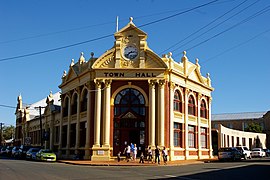York, Western Australia
|
York Western Australia |
|||||||
|---|---|---|---|---|---|---|---|

|
|||||||
| Coordinates | 31°53′18″S 116°46′07″E / 31.88833°S 116.76861°ECoordinates: 31°53′18″S 116°46′07″E / 31.88833°S 116.76861°E | ||||||
| Population | 2,387 (2011 census) | ||||||
| Established | 1835 | ||||||
| Postcode(s) | 6302 | ||||||
| Elevation | 179 m (587 ft) | ||||||
| Location | 96 km (60 mi) E of Perth | ||||||
| LGA(s) | Shire of York | ||||||
| State electorate(s) | Central Wheatbelt | ||||||
| Federal Division(s) | Pearce | ||||||
|
|||||||
York is the oldest inland town in Western Australia, situated 97 kilometres (60 mi) east of Perth, and is the seat of the Shire of York. The York district and town took its name from York County, Western Australia (in turn named after Prince Frederick, Duke of York and Albany). The area was first settled in 1831, two years after Perth was settled in 1829. A town was established in 1835 with the release of town allotments and the first buildings were erected in 1836.
With the increasing population of the Swan River Settlement in 1830, it became evident that suitable land would have to be discovered for the growing of crops needed to provide necessary food.
Ensign Robert Dale, a 20-year-old officer of the 63rd Regiment, led a small party in the first exploratory journey over the Darling Range, during the winter months of 1830 into what was later to be known as the Avon Valley.
As a result, Lieutenant-Governor Stirling decided that the new district should be thrown open for selection and this was done by Government Notice on 11 November 1830. By December 1830, 250,000 acres had been allotted, and in January 1831, 80,000 acres. Before the end of 1831 a further 6,030 acres in small lots had been taken up.
In September 1831 Dale escorted the first party of settlers to the district, reaching the Avon valley on 16 September. They immediately set about the construction of huts, the preparation required for their stock and the cultivation of new land. Dale proposed an area two miles south of the summit of Mt Bakewell as the site for a future town to serve the district.
In September 1833 a garrison of eight troops of the 21st North British Fusiliers was stationed at York. Rules and regulations for the assignment of town allotments at York were gazetted in September 1834 and allotments were advertised for sale from July 1835.
A township did not begin to appear until 1836. In July 1836 York comprised two houses, a barn, an army barracks and some out-houses, with about 50 acres of cleared land.
...
Wikipedia

